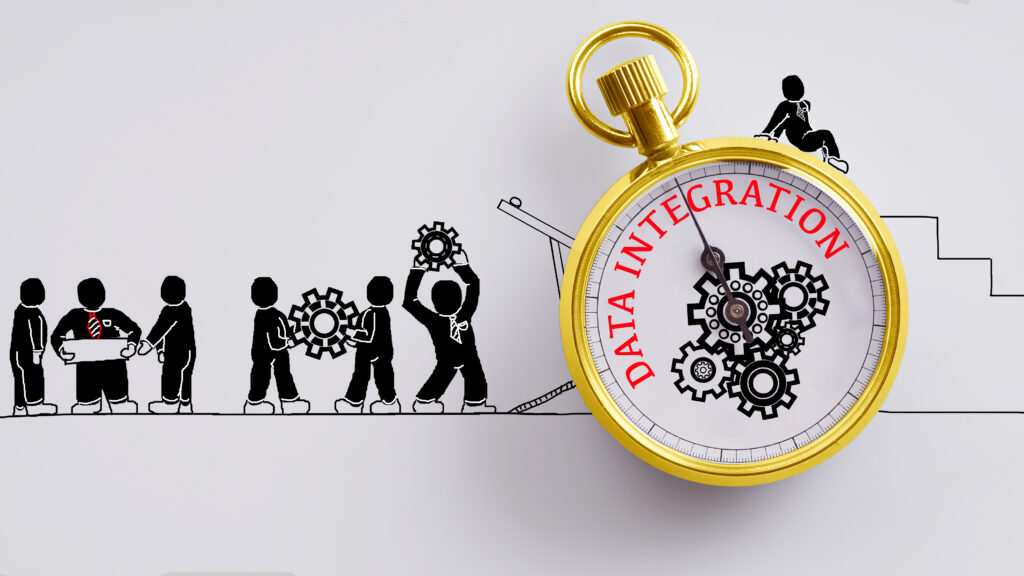
(Source – Shutterstock)
SnapLogic experts discuss the superpower of great data integration
Article by James Campbell, Regional Manager Australia & New Zealand, SnapLogic
With multitudes of applications and information sources all creating mountains of data, ensuring the data is managed and delivered to the right team at the right time can be overwhelming. Organizations must find a better, simpler way to access and analyze their data efficiently – doing so is key to making better data-driven decisions and winning in a saturated market.
In the recent Demystifying Data Integration: Automation Hacks Every IT Professional Should Know webinar hosted by SnapLogic, a leader in intelligent integration and enterprise automation; SnapLogic industry experts Jeremiah Stone, Chief Technology Officer, and David Wilmer, Principal Product Marketing Manager, broke down data integration.
From data integration challenges, the pros and cons of modern data integration methods, the benefits of automation and API management, and how enterprise automation makes organizations more competitive in a cut-throat landscape; it’s a must-watch for any leader who wants to drive success for his/her organization.
Data integration is critical to the success of organizations today
“Organizations know that integrated data instills data trust and that trust is critical in basing important business decisions on analytics,” Wilmer says. “But regardless of data integration’s importance, many organizations are still finding it difficult.”
In fact, according to recent SnapLogic research in partnership with Vanson Bourne, 83% of ITDMs (IT decision-makers) are not completely satisfied with the performance and output of their data management and data warehousing solutions. This dissatisfaction stems from issues relating to data formatting, regulations, and speed of data movement and accessibility within the organization.
On average, enterprises have approximately 254 applications, and 40-60 tools per team, and more than half (56%) of SaaS applications are not owned or managed by a company IT department. As app sprawl increases, data from each app gets siloed and becomes inaccessible to other parts of the organizations, teams, and apps.

James Campbell, Regional Manager Australia & New Zealand, SnapLogic
The data trust divide
According to the same SnapLogic research, more than half (53%) of respondents say they do not entirely trust their data for decision-making. Wilmer says this isn’t surprising, considering the number of disconnected data sources organizations typically have.
“At the same time, 40% don’t completely trust their data for decision-making because poor integration means data is missing or incomplete,” he points out. “Disparate data sources increase data silos. That means your data can’t flow between systems, which lowers the confidence in data.”
No data integration means no data insights, which leads to impaired decision-making – it’s an equation that adds up to adverse business outcomes and poor user experience. In fact, the average organization reports losing more than AU$1.45 million each year due to poor data management. To remedy this and leverage the power of SaaS, data must be integrated.
Breaking down modern data integration methods
To drive automation and better user experiences, data needs to be integrated across a variety of applications and systems within an enterprise. There are a number of ways to achieve that integration. However, many are complex and less than user-friendly. Let’s take a look at some modern data integration methods.
Data Federation: An integration and access layer that sits atop disparate and distributed data sources and enables them to be accessed as if they were a single source.
Pros:
- Data stays in original sources
- No need to migrate data
- Lower cost
Cons:
- Latency delays when querying
- Data and apps remain separate
Data Virtualisation: A virtual database that serves as a data access layer to applications and requires similarly formatted data or strict data models.
Pros:
- Querying is faster than federated
Cons:
- Data needs to be formatted
- May require data modeling
- Not as fast as more modern ways
Data Lakes: Storage repository that becomes a destination for disparate data sources. Data is moved to the lake, which can be small or extremely large. Handles a wide variety of data formats.
Pros:
- Deploy on-premise or in the cloud
- Can serve as a central data repository
- Data is easily accessible
Cons:
- Special skills required to manage
- Data professionals must handle data
- Slower query results
- Can become data dumping ground
Modern Cloud Data Warehouses: Data warehouses perform all the heavy lifting to transform non-relational data files into a relational structure that makes it easier and faster to extract and analyze data.
Pros:
- Supports multiple formats
- Uses column formatting
- Faster access and analysis
- Separates storage from compute
- Can integrate with data lakes
Cons:
- May be better to separate out data lakes
- Limits org to the same data warehouse
- Slower query results
- Can become a data dumping ground

(Source – Shutterstock)
Hacks to streamline and simplify your data
Leveraging modern tools and technology is the ultimate hack organizations can implement to streamline and simplify complex integration processes. The first way to do this is by eliminating manual coding. “Manual coding is tedious,” Wilmer says. “It’s prone to errors. It requires specialized skills. So you want to look for a modern platform that provides low/no code solutions.”
Low/no code solutions benefit entire organizations because they can be used by everyone, regardless of profession. These easy-to-use solutions empower staff to solve complex problems without relying on IT engineers to make sense of the data first.
“Everyone from tech-savvy engineers to business-savvy analysts needs to have access to data when and where they need it,” Wilmer stresses. “It should no longer be the bottleneck to business success.”
Stone agrees, adding that while he loves expressive development, code-centric integrations reduce the accessibility of the business rules that are codified into those integrations.
“Organizations reap tonnes of benefits by taking a visual, no/low code approach to integration,” Stone explains. “For one, it’s accessible to people with business knowledge. But also, customer after customer that I’ve worked with finds that it reduces the risk of management and maintenance of those integrations because they’re actually easier to hand off between team members.
“Integration is a clever way to solve a difficult, persistent problem,” he continues. “The combination of seeing how you can empower different skill sets to participate in the integration process and using a model-driven or visual way to create, support, and maintain the integration is a powerful approach to solving any problem.”
Another way to simplify the complex is to focus on event-driven circumstances. Wilmer says there’s still a time and place for ‘bulk and batch’ processing, but an agile business needs real-time insights, which can only be achieved through streaming and API event-based data movement. “Modern applications need to be connected to share data,” he explains. “Event-driven data sharing powers enterprise automation.”
Beyond that, it’s important to scale with the cloud. “Obviously, when batch and the high-volume process is necessary — and it will be — we want to scale with the cloud,” Wilmer adds. “Cloud computing has brought a seemingly limitless ability to reach peak performance and data processing.
“A data integration platform cannot be the bottleneck to achieving this agility. Look for a data platform that is born on the cloud and has the same ability to automatically scale with the cloud to maintain the desired performance.”
Finally, when it comes to simplification, think: about consolidating integration. “It shouldn’t take four separate tools that specialize in only one or two methods of data integration to achieve business goals and objectives,” Wilmer insists. “Look for a complete integration platform that can do all four simultaneously to achieve integration, application integration, API management and governance.”
Winning with intelligent integration and automation
The enterprises that will win in the data economy are those that can harness data from every source and turn it into powerful insights. With data as the driving force of the future, it’s imperative to have an integration platform that can seamlessly integrate, automate and mobilize data to any data warehouse with a simple, powerful solution.
Successful integration leads to positive business outcomes and desirable user experiences. That’s why data-driven organizations integrate data to build a single source of truth. “This takes blending operational data with historical data, which involves data warehousing, capturing real-time data and streamlining data for analytics — all things that deliver immediate and tailored customer experiences,” Wilmer says.
“The more automated this becomes, the quicker you can achieve these outcomes. Enterprise automation drives efficiencies in technology, so you can deliver the goals and promises of your business.”
Stone adds, “Think of it this way, everyone always wants to eat the ice cream first. But you have to eat your broccoli first. Integration is like eating your broccoli to get strong and get those payoffs and benefits.”
Watch the full, on-demand webinar here.
The views in this article is that of the author and may not represent the views of Tech Wire Asia.
[About the Author]
James Campbell, Regional Manager, Australia New Zealand at SnapLogic
James Campbell is Regional Manager, Australia New Zealand at SnapLogic. With nearly two decades of experience, James is a seasoned B2B tech leader with a strong track record of managing high-performance teams while consistently delivering against key business objectives. James thrives on helping customers derive immense value from SnapLogic technology.
About SnapLogic
SnapLogic powers the automated enterprise. The company’s self-service, AI-powered integration platform helps organizations connect applications and data sources, automate common workflows and business processes, and deliver exceptional experiences for customers, partners, and employees. Thousands of enterprises around the world rely on the SnapLogic platform to integrate, automate, and transform their business. Learn more at snaplogic.com.
Connect with SnapLogic via its Blog, Twitter, Facebook, or LinkedIn.
READ MORE
- 3 Steps to Successfully Automate Copilot for Microsoft 365 Implementation
- Trustworthy AI – the Promise of Enterprise-Friendly Generative Machine Learning with Dell and NVIDIA
- Strategies for Democratizing GenAI
- The criticality of endpoint management in cybersecurity and operations
- Ethical AI: The renewed importance of safeguarding data and customer privacy in Generative AI applications




